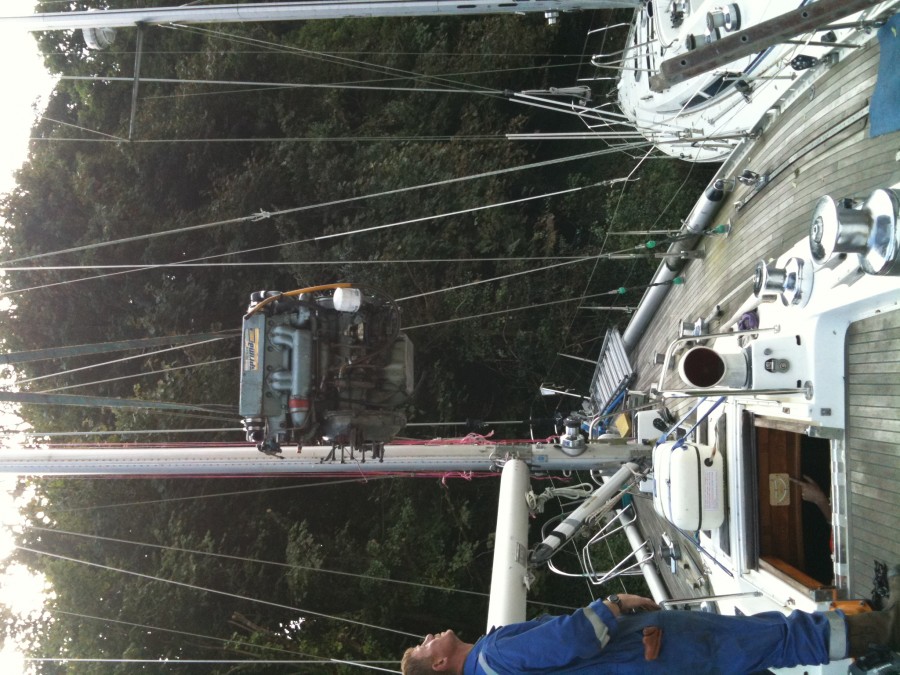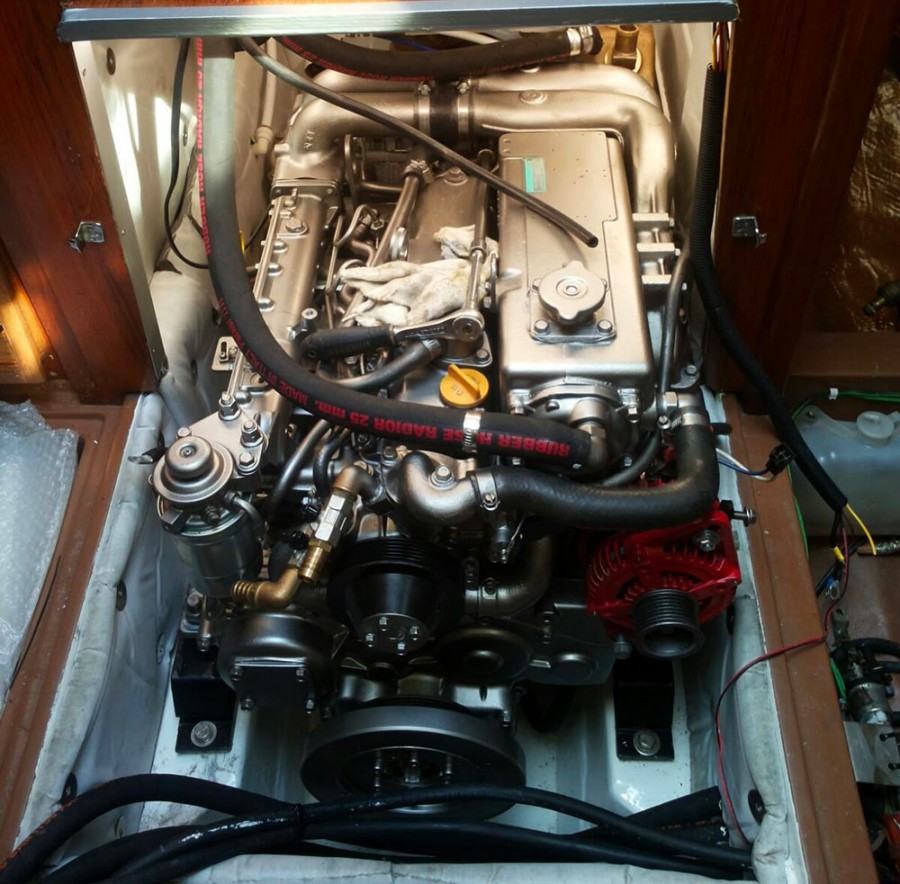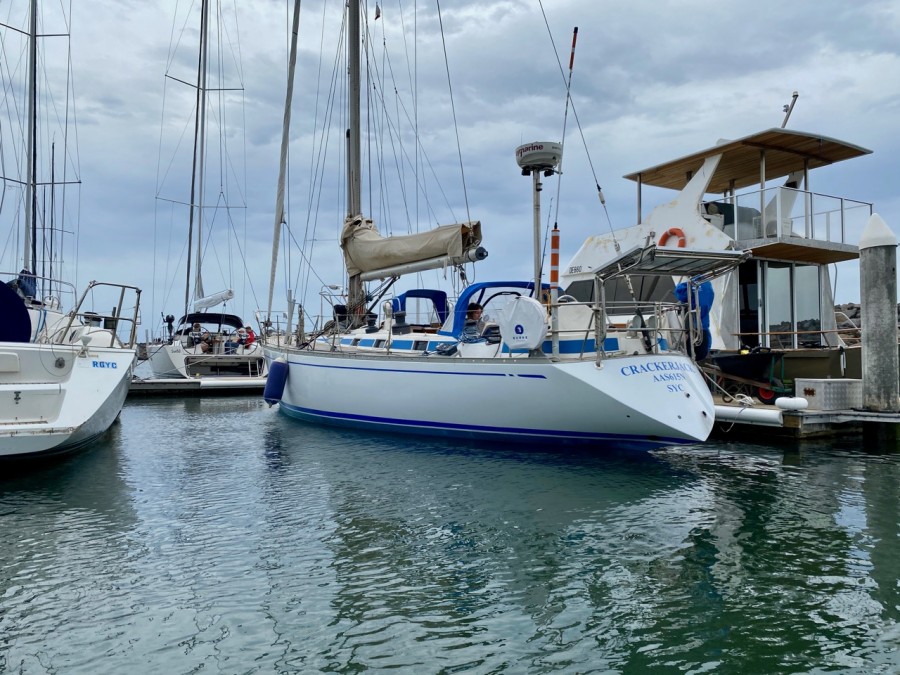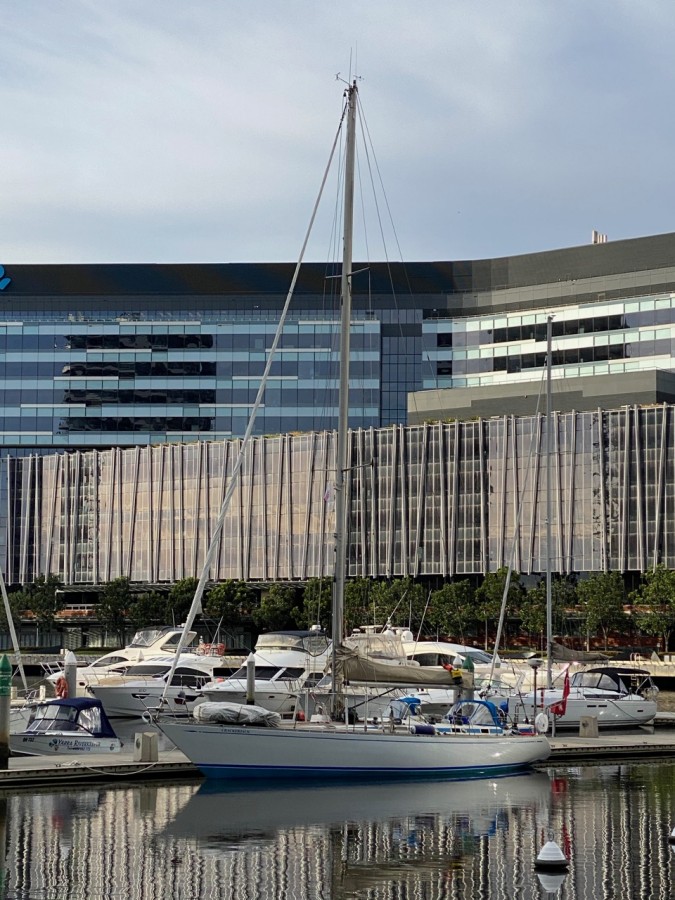Do you want to be informed on new Posts on this Thread? (members only)
| S&S Swan Maintenance - New engine installation |
|---|
|
Join Date: 16 February 2007
Posts: 199 |
||
|---|---|---|
|
New engine installation During the winter-spring 2008 a new engine was insatlled in "Farouche", my swan 47 hulll nr. 50. The installation was a little problematic due to a rather cramped space in the so called engine room! After many attempts and rearrangements of the foundations the installtion coud be successfully finalised. The new engine, a Volvo Penta D2-75 being shorter than the old one, an MD21A, we had to fit a new and longer propeller shaft, with numerous related parts. The centering and the balancing of the engine was quite a challenge. This process is an art and demands a lot of attention, concentration and ingenious creative solutions. That process was hard one! however, after many attempts and patience, the result was a total success. This summer I had many occasions to try the engine in various pace. At 2000 RPM, the speed is just over 8 knots. Super, is it not? Cheers/Philippe-Swan47/50 "Farouche" |
|
Join Date: 01 February 2007
Posts: 35 |
||
|---|---|---|
|
Over 8 kn with 2000 rpm with 75 hp. Ok! what kind of prop do you have? Must be quite special. Regards Cygnus Peña |
|
Join Date: 14 June 2019
Posts: 10 |
||
|---|---|---|
|
During the winter-spring 2008 a new engine was insatlled in "Farouche", my swan 47 hulll nr. 50. The installation was a little problematic due to a rather cramped space in the so called engine room! After many attempts and rearrangements of the foundations the installtion coud be successfully finalised. The new engine, a Volvo Penta D2-75 being shorter than the old one, an MD21A, we had to fit a new and longer propeller shaft, with numerous related parts. The centering and the balancing of the engine was quite a challenge. This process is an art and demands a lot of attention, concentration and ingenious creative solutions. That process was hard one! however, after many attempts and patience, the result was a total success. This summer I had many occasions to try the engine in various pace. At 2000 RPM, the speed is just over 8 knots. Super, is it not? Cheers/Philippe-Swan47/50 "Farouche" Hi Phillipe, I am looking to replace my old perkins 4154 with either a 75hp Yanmar or 80hp Vetus, but I would like to ask your opinion / experience on the following: - How did you lift out the old engine, did it come out in one piece, or did you break it down? - did the new engine fit through the main companion way? Again, did it need to be taken apart and rebuilt inside the cabin? - What equipment did you use to lift the engines, was it an external crane or did you construct a jig propped over the deck? Both the Yanmar and the Vetus are about 30% lighter and smaller than the Perkins, so I dont think I will be struggling for space, but may need to construct new engine mount points to the hull. Any advice with this job would be greatly received. Kind regards
Philip (Crackerjack, Swan 47 No. 65) Melbourne, Australia. |
|
Join Date: 02 January 2008
Posts: 1547 |
||
|---|---|---|
|
Dear Philip It is suggested consideration should be paid to the rpm of the new engine. For this the propeller curves should be compared, and I have done this for you, pls see below.
The propeller curve shows how much power is transferred to the water at various rpms.
It can be seen that the Vetus engine requires about 25% higher rpm for the same power, this refers over the entire rpm range, and can not be affected with the reduction ratio.
If adjustments to the engine bed height are required, the recommendation is to use steel spacers under the new engine mounts.
Kind regards
Lars
|
|
Join Date: 24 April 2020
Posts: 18 |
||
|---|---|---|
|
I recently bough 47/048 which had been re powered 4 years ago with a Yanmar 4JH4HTE 110 hp turbo charged engine. Not to put too fine a point on it - access to everything sucks! Changing the raw water pump impeller requires the entire pump to come off as it is impoosible to get a hand to the impeller cover as it faces aft. The oil filter is in the middle of the engine, starboard side where there is no access panel! The fuel filter is jammed up high on the "ceiling" of the engine space. Share this only to suggest that care be taken to note where these service points end up in the "engine room!"
Good luck Adrian Little Cygnus 47/048 |
|
Join Date: 01 March 2007
Posts: 147 |
||
|---|---|---|
|
Dear Phillip, I did a similar job in 2010, replacing the Perkins with a Yanmar 75. The old engine came out through the main companionway just fine, we used a telehandler. The Yanmar required new beds to to set it up correctly, and I think because it was shorter than the Perkins, the prop shaft was longer and required extra support because it was longer than the recommendations for unsupported length. We just addes another bearing aft. We removed the oil filter and located it on the side of the engine housing which makes filter changes easy. No problems accessing the water pump impellor or fuel filters. I think the Yanmar engine block is the same size as the 110HP which Adrian mentions, but perhaps the gearbox arrangement is smaller as we do not have the problems which Adrian mentions on Cygnus. Rob Sarabande 47/029  |
|
Join Date: 29 January 2007
Posts: 1033 |
||
|---|---|---|
|
Dear Philippe,  Vanessa engine in 2017, during winter maintenance |
|
Join Date: 14 June 2019
Posts: 10 |
||
|---|---|---|
|
Dear Philip It is suggested consideration should be paid to the rpm of the new engine. For this the propeller curves should be compared, and I have done this for you, pls see below.
The propeller curve shows how much power is transferred to the water at various rpms.
It can be seen that the Vetus engine requires about 25% higher rpm for the same power, this refers over the entire rpm range, and can not be affected with the reduction ratio.
If adjustments to the engine bed height are required, the recommendation is to use steel spacers under the new engine mounts.
Kind regards
Lars
Wow Lars, as always you have gone above and beyond!! That is very helpful information and great for helping with the engine selection process. As a side note, have you had any dealings with using DC electric motors as a power option? I think this may be the way of the future at some point as battery capacity improves, so I have been making enquiries into this as well. I would welcome your thoughts. |
|
Join Date: 14 June 2019
Posts: 10 |
||
|---|---|---|
|
I recently bough 47/048 which had been re powered 4 years ago with a Yanmar 4JH4HTE 110 hp turbo charged engine. Not to put too fine a point on it - access to everything sucks! Changing the raw water pump impeller requires the entire pump to come off as it is impoosible to get a hand to the impeller cover as it faces aft. The oil filter is in the middle of the engine, starboard side where there is no access panel! The fuel filter is jammed up high on the "ceiling" of the engine space. Share this only to suggest that care be taken to note where these service points end up in the "engine room!"
Good luck Adrian Little Cygnus 47/048 Hi Adrian, Yes, you are so right about that - it seems all of the modern engines are in this configuration of having the service items on the starboard side, I have definately noticed that. That is the only saving grace of the Perkins, everything is accessible and on the port side. I have considered the need to install a remote oil filter, to bring it back onto the port side, so it is accessible to the hatch under the sinks, but the other items would be very tricky. If I do go the Yanmar, my plan would be to bring it forward as far as possible under the companyon way box. Thanks verry much for the tip, greatly appreciated. |
|
Join Date: 14 June 2019
Posts: 10 |
||
|---|---|---|
|
Dear Phillip, I did a similar job in 2010, replacing the Perkins with a Yanmar 75. The old engine came out through the main companionway just fine, we used a telehandler. The Yanmar required new beds to to set it up correctly, and I think because it was shorter than the Perkins, the prop shaft was longer and required extra support because it was longer than the recommendations for unsupported length. We just addes another bearing aft. We removed the oil filter and located it on the side of the engine housing which makes filter changes easy. No problems accessing the water pump impellor or fuel filters. I think the Yanmar engine block is the same size as the 110HP which Adrian mentions, but perhaps the gearbox arrangement is smaller as we do not have the problems which Adrian mentions on Cygnus. Rob Sarabande 47/029 Thanks so much Rob, your response make this process a lot more palatable, I was worried that there was going to be a whole additional exercise in remote engine building!! Yes, the spec's for the TE show a smaller transmission, with a slight weight reduction, but I have heeded Adrians warnings and will try and reconfigure some of the consumable's locations, if I go down the Yanmar route. I have had experieince retrofitting a Chev 6.2 V8 into a old LR defender, so I know the movement of ancillaries is definately possible!! The photos and information is very very helpful, I am very grateful for the response. I need all the help I can get to bring Crackerjack back to her former glory!! Thanks Again Rob, Philip |
|
Join Date: 14 June 2019
Posts: 10 |
||
|---|---|---|
|
Dear Philippe, Hi Mattaeo, Thanks so much for the response and for the Association and Forum, it takes my breath away just seeing the responses everyone has made. Lars is a rock as always, I love it!! I had read your previous notes about your motor, so I was leaning towards the smaller motor based on your experience. P.S How did the Variprop go? Did you resolve the vibration and is it as good as you expected? We have undertaken a lot of work on Crackerjack this year, cleaned up the topsides and done a lot of repairs and upgrades....there are now a lot of interested people stopping and admiring her, however I am still amazed that the name Nautor Swan is not that well recognised here, so I am trying to change that! Kind regards, Philip  Crackerjack in her berth in Sandringham YC  Crackerjack in Melbourne Docklands on Monday |
|
Join Date: 02 January 2008
Posts: 1547 |
||
|---|---|---|
|
Dear Philip Yes, I have been involved with electrical propulsion.
It is worthwhile to choose a system which can also charge the batteries during sailing.
If the voltage is maximum 48 V you are allowed to work on the installation yourself, if higher than that authorized electricians are required (at least here).
The advantage with higher voltage is that the components are smaller.
Kind regards
Lars
|
|
Join Date: 29 January 2007
Posts: 1033 |
||
|---|---|---|
|
Dear Philip, |
|
Join Date: 01 March 2007
Posts: 147 |
||
|---|---|---|
|
Thanks so much Rob, your response make this process a lot more palatable, I was worried that there was going to be a whole additional exercise in remote engine building!! Yes, the spec's for the TE show a smaller transmission, with a slight weight reduction, but I have heeded Adrians warnings and will try and reconfigure some of the consumable's locations, if I go down the Yanmar route. I have had experieince retrofitting a Chev 6.2 V8 into a old LR defender, so I know the movement of ancillaries is definately possible!! The photos and information is very very helpful, I am very grateful for the response. I need all the help I can get to bring Crackerjack back to her former glory!! Thanks Again Rob, Philip Dear Phillip, Good luck with the re-engine works, I have been very pleased with mine. ( we experimented with different propellors, but reverted to the Maxprop which has always been good for us).Lovely to see those pictures of Crackerjack looking sharp and on her lines, and for me it is particularly good to see her as I am fairly sure she was skippered by a dear late friend of mine in her early years, and it was he who advised me when I bought Sarabande in 2000. Best Rob Sarabande 47/029 |
- Threads : 1715
- Posts : 10273
- Members: 823
- Online Members: 0

